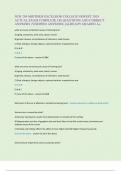NUR 209 MIDTERM EXCELSIOR COLLEGE NEWEST 2024
ACTUAL EXAM COMPLETE 180 QUESTIONS AND CORRECT
ANSWERS (VERIFIED ANSWERS) |ALREADY GRADED A+
what are some conductive causes of hearing loss?
A) aging, ototoxicity, loud noise, blasts, tumors
B) genetic disease, virus/diseases of infections, head trauma
C) fluid, allergies, foreign objects, ruptured eardum, impacted ear wax
D) A & B
E) B & C
F) none of the above - answer-E) B&C
what are some sensorineural causes of hearing loss?
A) aging, ototoxicity, loud noise, blasts, tumors
B) genetic disease, virus/diseases of infections, head trauma
C) fluid, allergies, foreign objects, ruptured eardum, impacted ear wax
D) A & B
E) B & C
F) none of the above - answer-D) A&B
What part of the ear is affected in conductive hearing loss? - answer-external or middle ear dysfunction
Sensory loss is caused by what?
A) Sensory hearing loss results from deterioration or atrophy of the cochlea
B) Degeneration and loss of ganglion cells and their fibers in the 8th cranial nerve, brainstem and
auditory areas of the cortex
C) Gradual and initially affects the ability to hear higher pitched (higher frequency) sounds.
D) all of the above - answer-D) all of the above
Sensorineural impairment can be caused by what?
,A) ototoxic medication medications (ex: NSAID, antibiotics, amino-glycosides, streptomycin, loop
diuretics)
B) meniere's disease (endolymph buildup in the labyrinth interferes, with normal balance and hearing
signals between the inner ear and the brain causing vertigo and other symptoms
C) Neither a nor B
D) both A and B - answer-D) both A and B
What does the weber test diagnose?
A) vision impairment
B) kidney impairment
C) hearing impairment
D) heart disease - answer-Hearing impairment
How does the weber test work - answer-tunning fork is gently set vibrating and it is held firmly on the
patient's forehead in the midline for a few seconds - pt is then asked if the tone is heard more clearly on
one side (lateralization) or if they cannot identify a side which hears the tone better (no lateralization)
If there is no lateralization there is unlikely to be asymmetric hearing loss
How does the Rinne test detect significant conductive hearing loss? - answer-Tunning fork is held firmly
on the mastoid for a few sec while the fork is still vibrating. it is then moved close to the ear canal and pt
is asked which position the tone is heard louder
ear with significant conductive hearing loss hears bone conduction than air conduction
Comparison of Rinne test and Weber test? - answer-Weber tests localization of hearing loss while rinne
tests conducive hearing loss
What is not a way to manage hearing impairment
A) speak directly and face the person
B) environmental modifications
C) assistant listening devices
,D) antihypertensive drugs
E) hearing aids - answer-D) antihypertensive drugs
What is a fall - answer-an event which results in a person coming to rest inadvertently on the ground or
floor or other lower level
Risk factors of falls include all but the following
A) activity related
B) additive
C) differ according to place of residence
D) healthy diet
F) multifactorial - answer-D) healthy diet
Intrinsic risk factors
A) age, history, chronic illness, cognitive and somatosensory impairment, dizzy, visual impairment, fear,
medications, lower extremity disability, non-independent ADLs
B) floors, lighting, stairs, walkways, entrances, furniture, bathroom
C) osteoporosis, incontinence and home hazards - answer-A
what is the single most important predictor of future falls - answer-history of prior falls
extrinsic risk factors
A) age, history, chronic illness, cognitive and somatosensory impairment, dizzy, visual impairment, fear,
medications, lower extremity disability, non-independent ADLs
B) floors, lighting, stairs, walkways, entrances, furniture, bathroom
C) osteoporosis, incontinence and home hazards - answer-B
Assessment of risk for falls includes what components? - answer-history, subjective questions, physical
exam, assessment of other factors
, What are the two important questions in a subjective assessment? - answer-have you fallen in the past
12 months and are you afraid of falling
Yes to either = increased risk
What are some factors of the physical exam
A) ROM and strength
B) tone and sensation
C) pain and deformities
D) gait and balance
E) all of the above - answer-E) all of the above
Timed up and go assessment - answer-stand from chair and walk 3m to the line in under 13.5sec
if over the time frame = high falls risk
BEEEACH falls prevention model includes what
behavior change, education, equipment, environment, activity, clothing and footwear, health
management - answer-behavior change, education, equipment, environment, activity, clothing and
footwear, health management
what are some BEEEACCH education interventions
A) walkers, alarms, lifts, hip protectors
B) staff, residence, families
C)exercise programs, physio, recreation
D) proper lighting, non - slip/low glare floor, rest stops in halls, call bells, clutter free room
E) good shoes, treaded socks
F) regular toileting - answer-B
what are some BEEEACCH health management interventions




